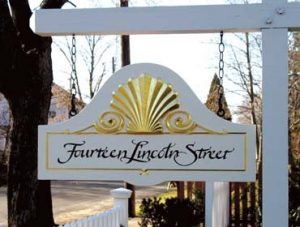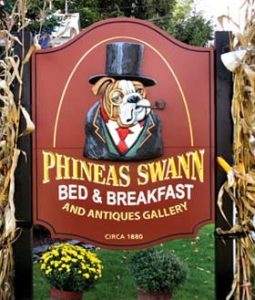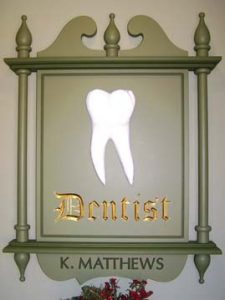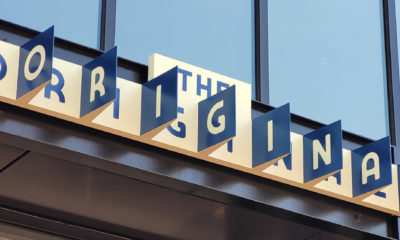Dimensional Signs
Spring Forward
Spring Valley Signs’ unorthodox business model gains a unique niche.
Published
18 years agoon
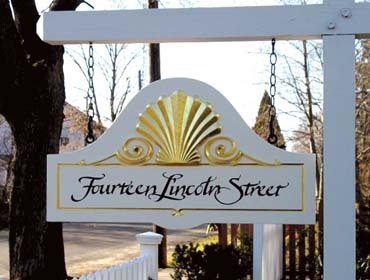
Many in the industry bemoan signage's accelerating homogeneity. As big-box stores increasingly dominate the commercial landscape, companies increasingly tend to adopt a "follow the herd" mentality. Thus, competition often kills originality in the development of environmental graphics.
However, as with any type of commerce, some motivated, individualistic signmakers buck the trends (skeptics would say at their own peril) and pursue niche markets with clientele who appreciate traditional, handcrafted fabrication and decoration methods.
Farmington, PA-based Spring Valley Signs embodies a low-tech philosophy of manual fabrication and a refreshingly old-school dedication to craftsmanship. Bob Burnett, the company's production manager (no one can truly be called an owner of the company — the Bruderhof community, a Christian-based religious group that communally shares property, ultimately operates the shop), described how Spring Valley Signs uses abundant talent to fabricate distinctive signage.
International beginnings
Spring Valley Signs is closely linked to Danthonia Designs, another Bruderhof-based signshop that was founded in Minnesota in 1992, but moved to Australia a few years later. Danthonia — which is located in New South Wales, Australia, and operated by Joe McKernan — has earned several awards in past ST contests and, according to Burnett, is the only handcarving signshop Down Under.
In 2002, Danthonia opened a sales office in upstate New York, but Burnett opted the following year to branch out and open a signshop due to delivery costs from Australia, as well as the sign-code disparity between the two nations.
Advertisement"Australia, by nature, is a more wide-open country," Burnett said. "They have relatively few restrictions on sign codes. Here, it's not very often we can fabricate an HDU sign panel larger than 20 sq. ft., so we thought it was more practical to assume sign production here, because we're more familiar with the market, and to reduce shipping costs."
The daily grind
Most of the company's work comprises one- or two-piece, custom jobs. At the time of the interview, Burnett said there were 53 projects on the shop floor. HDU comprises more than 90% of the shop's projects.
He doesn't intend to slight signmakers who use wood, but he's received many complaints from business owners who've criticized its inability to withstand the elements (not to mention, wood's integral grain and potential knots, which pose major fabrication roadblocks).
Although Spring Valley Signs has largely replaced a sign substrate used for centuries, perhaps millennia, with a perceived better product, it has generally adhered to time-honored signmaking techniques. They continue to use a complement of approximately 40 German chisels, as well as power tools, rasps, files and other equipment, to fashion their signs. Its one nod to technological innovation is its use of SA Intl.'s (Philadelpahia) FlexiExpert software to design its graphics.
Burnett knows his methods go against the grain, but he firmly believes his methods deliver optimal results.
Advertisement"My friends in the industry always kid me that it will just be a matter of time until I break down and buy a CNC router," he said. "But, through giving everyone who works in the shop hands-on training with chisels and other signmaking tools, I think we have a better idea of the depth and texture that a sign should have than a machine."
To fortify the shop's HDU panels, the fabricators laminate PVC sheets behind the HDU, or, for double-sided signs, as protection for the sandwiched layer. Burnett said this is especially important for two-sided signs because they're highly susceptible to wind and abrasion.
The shop's dimensional letters typically entail incise carving, with rasping for finer detail. To decorate their works of art, Spring Valley's painters use Benjamin Moore's exterior-grade latex as a basecoat and, for added splashes of color, Liquitex artists' acrylics and 1Shot® lettering enamels. Their coating process involves two coats of primer, with approximately six hours of curing time between coats, followed by three topcoat layers — the first two coats cure for four hours, and Burnett allows the third layer to dry for 24 hours.
Closing the sale
Burnett believes every customer walks into his shop with a different level of conceptual organization and emotional investment in his signage — some are quite particular, others are particularly clueless, but most fall in between.
After one of Spring Valley's staff designers interviews the client, the design and fabrication teams develop three conceptual renderings from which the client may choose the best for their needs. Burnett thinks it's best to be above-board from the outset.
Advertisement"If a potential customer's budget is the driving factor, I'll usually tell him we're not the fabricator for him," Burnett said. "If all he can afford from us is a 10-sq.-ft. sign, that's too small of a sign to really help his image. Sometimes, I suggest he find a temporary sign solution and return when he can afford a more permanent sign."
Burnett said the company receives most of its business through word of mouth or its website, www.springvalleysigns.com. He's also helped cultivate niche clientele through participation in Wineries Unlimited, an annual wine-industry tradeshow in Lancaster, PA. It's been fruitful — the company's road-ID sign for Tassel Ridge, an Iowa winery, earned second place in the Commercial Pole/Pylon category in the 2006 ST/ISA International Sign Contest (see ST, April 2006, page 125).
"Wineries generally attract upscale customers, and their owners are generally more inclined to specify larger sign programs with goldleaf, more defined carving and other high-end elements," Burnett said. "Developing a good reputation and pursuing the type of work many shops don't do has spurred our success."
The shop also caters heavily to bed and breakfasts, which have long been a haven for the free-spirited or affluent traveler. John Perkins and Jay Kerch, co-proprietors of Montgomery Center, VT-based Phineas Swann Bed & Breakfast, sought a distinctive sign that reinforced its image as an historic (the house was built in 1880), yet pet-friendly (according to the inn's site, Kerch has nestled roughly 4,000 pieces of canine paraphernalia throughout its confines) establishment.
Unsure of what his clients wanted after the design interview, Burnett chose to incorporate "Phineas," an English bulldog, as the sign's central icon — that breed befits the whimsical design, he said. The design features the canine bedecked with a top hat, monocle, pipe and suit.
Affirming that he's a first-class pooch, the fabrication team framed him with an incise-carved, 23k, German-goldleaf arch, and incorporated slightly curved, gilded, primary text and secondary text decorated with brilliant-white artists' acrylic paint. The clients originally wanted all-gold lettering, but they ultimately agreed to the color contrast when Burnett insisted it would draw more attention to the sign. He said it was one of the most enjoyable signs the shop has fabricated.
Back to the future
Though Burnett acknowledges that signage now veers towards electric and electronic applications — or economical alternatives when commercial work is necessary — he's enthusiastic about the shop's future.
"We do work for customers all over the country; I'd say we fabricate roughly 1,000 signs a year," he said. "Banks, as well as lawyers' and dentists' offices, are always solid customers, but gilded signage has become a much easier sell."
Retention isn't an issue for the shop. All of the workers live in the Bruderhof community, so subcontracting is unnecessary. Burnett said, at peak times, up to 65 artists are available onsite to help. And, the community also operates a metal shop that handles all phases of scroll and installation-equipment fabrication — which it sends to customers, who make their own installation arrangements — except powdercoating.
However, he added that centuries of staff experience aren't a substitute for being attentive to a customer.
"A transaction gives you a small window into a client's wants and needs," Burnett said. "A businessman can be cold and indifferent, or he can take the time to understand the nature of his enterprise. In the long run, I think it's more rewarding, personally and financially, to listen."

SPONSORED VIDEO
Introducing the Sign Industry Podcast
The Sign Industry Podcast is a platform for every sign person out there — from the old-timers who bent neon and hand-lettered boats to those venturing into new technologies — we want to get their stories out for everyone to hear. Come join us and listen to stories, learn tricks or techniques, and get insights of what’s to come. We are the world’s second oldest profession. The folks who started the world’s oldest profession needed a sign.
You may like

INX Promotes Three to Vice President

6 Sports Venue Signs Deserving a Standing Ovation

Hiring Practices and Roles for Women in Sign Companies
Subscribe

Bulletins
Get the most important news and business ideas from Signs of the Times magazine's news bulletin.
Most Popular
-

 Tip Sheet4 days ago
Tip Sheet4 days agoAlways Brand Yourself and Wear Fewer Hats — Two of April’s Sign Tips
-

 Business Management2 weeks ago
Business Management2 weeks agoWhen Should Sign Companies Hire Salespeople or Fire Customers?
-

 Women in Signs2 weeks ago
Women in Signs2 weeks ago2024 Women in Signs Award Winners Excel in Diverse Roles
-

 Real Deal5 days ago
Real Deal5 days agoA Woman Sign Company Owner Confronts a Sexist Wholesaler
-

 Benchmarks1 day ago
Benchmarks1 day ago6 Sports Venue Signs Deserving a Standing Ovation
-

 Editor's Note1 week ago
Editor's Note1 week agoWhy We Still Need the Women in Signs Award
-

 Line Time2 weeks ago
Line Time2 weeks agoOne Less Thing to Do for Sign Customers
-

 Product Buying + Technology1 week ago
Product Buying + Technology1 week agoADA Signs and More Uses for Engraving Machines
